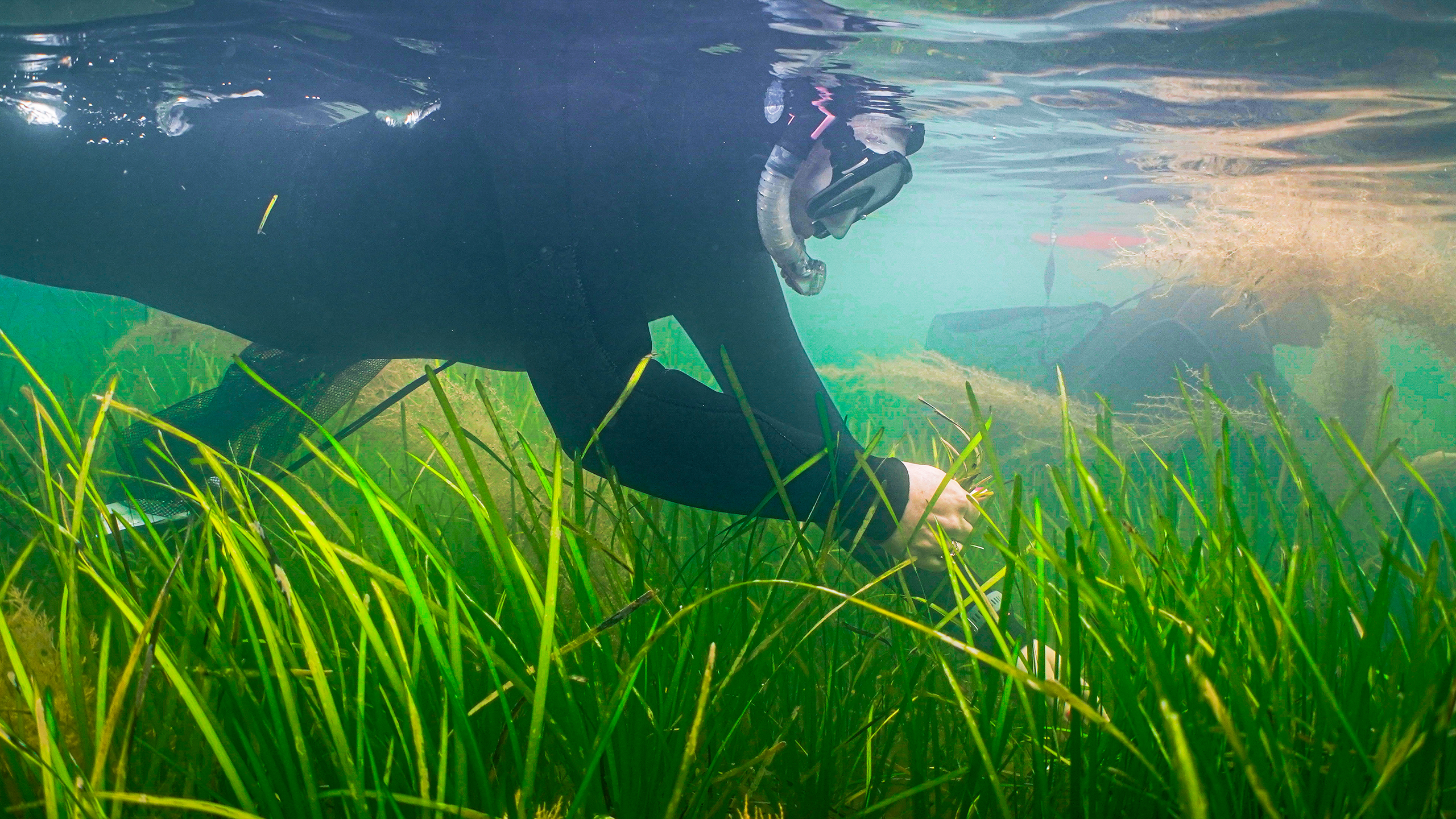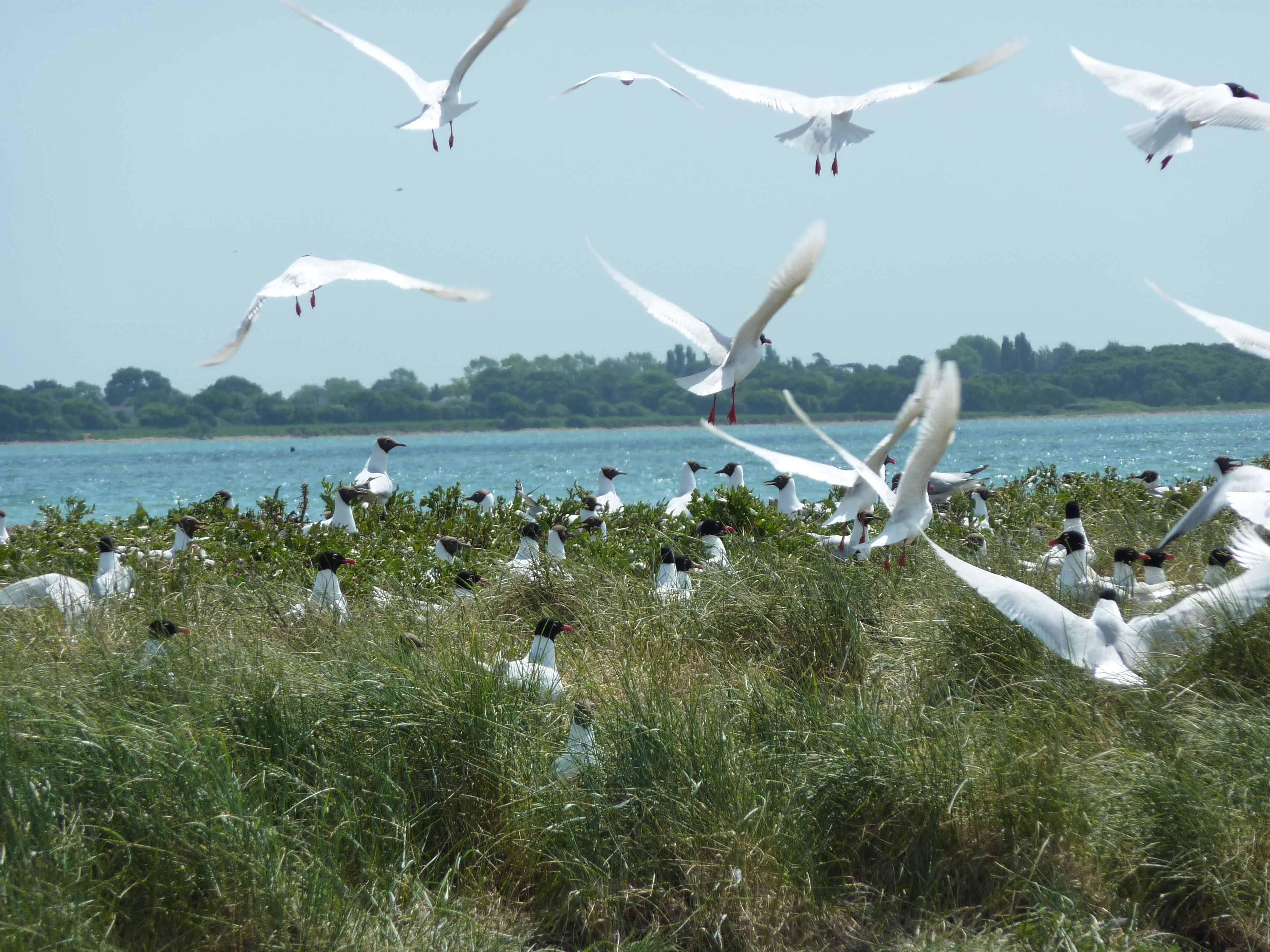Solent Seascape
The momentous effort to restore a precious marine world

In this series, we visit the projects made possible by the Endangered Landscapes & Seascapes Programme. These restoration landscapes are bringing back nature on a massive scale.
Seagrass meadows
It’s 5am on a brisk spring morning. The tide is low and the ground squelches under your feet. The sun’s rays yawn and stretch, revealing budding tufts of seagrass – shoots of green clinging fast in pale blue marsh. Around you are fellow volunteers in wellies and wetsuits, planting seeds before anyone else is up.
Your seeds have been harvested from the vestiges of Solent seagrass, overwintered in specialist labs, and now rest in your palm. You put the seeds into a caulking gun and inject them into a perfect patch of sediment.
Seagrass is a safe haven for vital fish species. It stores carbon and reduces coastal erosion, bolstering UK shores in the fight against climate change.
You know seagrass has grown here before, a long time ago. It gives you hope, alongside the newborn sun, that it can grow here again.
Meet Louise MacCallum, Solent Project Manager for the Blue Marine Foundation, lead partners in the Solent Seascape Project. The project comprises 10 organisations that are focused on collaboratively ensuring that Solent restoration initiatives have the best chance of success, and have a positive impacts for people and nature.
Louise grew up beachcombing in West Wales, spending every spare moment scouring the sandline for treasure. After a degree in Marine Biology, she moved to the Solent and felt its bewitching pull. Now, she’s managing a momentous effort to restore this precious seascape.
“We’re focused on restoring seagrass meadows, saltmarshes, oyster reefs and seabird nesting sites. They each provide vital ecosystem services, which benefit the landscape and the people who live here. And we hope to implement better management for the habitats which still exist. We still have some seagrass and remnants of the oyster population.”
As it stands, these remnants of a thriving ecosystem are fragmentary. Louise wants to knit them back together.
“These habitats are not as healthy or productive as they could be. If we restore them, species can have more access to safe nurseries, critical resources and be able to move freely between habitats once more.”
“I believe we can make a better Solent for everybody.”
Louise MacCallum, Solent Project Manager for the Blue Marine Foundation

Solent Seascape
The Solent is a rare gem. Stretching between the UK mainland and the Isle of Wight, the waterway is an internationally renowned wildlife hub and maritime centre.
The Isle of Wight generates a double-tide phenomenon in the Solent, and shields its length from harsh southwesterly winds. These unusual conditions are a boon to the local wildlife, allowing rare habitats to form. Solent dwellers enjoy sand banks, shingle spits, natural harbours, mud flats and estuaries.
Eagle-eyed visitors can spot unusual locals: a mixed colony of Harbour and Grey Seals, translucent and shimmering seahorses, and wading birds wintering here on their way down from the Arctic Circle.
The Solent’s conditions are also ideal for shipping purposes, with other residents including the Royal Navy, who use its natural barriers to shelter from storms.
Partly due to this popularity among humans, the Solent is under threat. Over the last 200 years, industrial activity and wasting diseases have combined to devastating effect. The Solent’s keystone habitats and species have been depleted, with some disappearing altogether.
Seal in water, credit: Blue Marine Foundation / Luke Helmer
Seal in water, credit: Blue Marine Foundation / Luke Helmer
A better Solent for everybody
To kick-start a regeneration of this marine seascape, Louise’s team are focused on restoring habitats they know can thrive in this area, given the right conditions. By learning from local people and their shared histories, her team can piece together where seagrass meadows and oyster reefs used to be, and work to revive them.
“By seeking local expertise and monitoring our work carefully, we hope to inspire others, and pay our learnings forward to future restoration initiatives.
“I believe we can make a better Solent for everybody. We hope to create a system where human activities don’t come into conflict with local habitats and species, and where those habitats become more resilient.
“The restoration of nature in the Solent will be hugely beneficial from a human wellbeing and economic point of view.
“Increasing the water quality, connectivity and biodiversity of the region makes this place more beautiful, which has a positive effect on people’s mental health. More practically, fishermen also rely on biodiversity to make a living. And healthy coastal habitats like saltmarsh help to protect the land from coastal erosion and flooding.”
A short film on the project
The Endangered Landscapes & Seascapes Programme provided the initial funding for the Solent Seascape Project. Louise is full of praise for how the Programme has furthered the project’s mission.
“The people working for the Programme have such a high level of expertise, and provide us with incredible advice.
“They also connect us to their other projects across Europe. We’ve learned so much from restoration practitioners across the continent, even though we’re restoring completely different landscapes. There are so many parallels in the barriers we all face, and how we can be creative in all aspects of our restoration work. Sharing this knowledge with other projects has been inspiring and incredibly valuable.”
Learn more about the Solent Seascape Project.
There isn't much time to act, but we need to get restoration right. For an overview of how the Endangered Landscapes & Seascapes Programme is putting cutting-edge science to use, read our interview with Nancy Ockendon, the Programme's Science Manager.
Also: visit the coldest place in Spain, to meet a team reintroducing large herbivores. If you strain your ears, you might hear the galloping of Przewalski's horses.
The Endangered Landscapes & Seascapes Programme provides grants to projects which restore threatened environments across Europe. Projects made possible by the Programme have preserved over 250,000 hectares of land and sea, and helped to protect over 100 threatened species.
The Programme is managed by the Cambridge Conservation Initiative, a partnership between the University of Cambridge and ten of the world’s leading international biodiversity conservation organisations.
Published October 2024
The text in this work is licensed under a Creative Commons Attribution-NonCommercial-ShareAlike 4.0 International License

